A Study on the Efficiency in the Energy Harvesting Device Using Resonance of Pendulum
Abstract
1. Introduction
2. Methods
3. Results and Discussion
4. Conclusions
- A mathematical analysis model of a generator using the resonance of the pendulum was constructed, and the time taken to start power generation and the amount of work input to the generator were derived.
- The potential energy of the pendulum was defined as amount of power generated the pendulum from the power generation angle at which power generation was started, and the output work of the generator was derived.
- The efficiency of the generator was defined using the work input to the generator and the work output, and the design variables affecting the generator efficiency were presented.
- The effect of the design variables on the efficiency of the generator was confirmed using an efficiency graph that considered the pendulum length, pendulum mass, and the angle at which power generation is started.
- As an additional study, it may be possible to manufacture an energy harvesting device using the resonance of the pendulum and measure the power generation efficiency according to design factors.
- To consider the practical effect of the energy harvesting device using the resonance of the pendulum in this study, future studies on the model including the pre-generator and motor and generator (MG) may be conducted.
Author Contributions
Funding
Conflicts of Interest
References
- Withagen, C. Pollution and Exhaustibility of Fossil Fuels. Resour. Energy Econ. 1994, 16, 235–242. [Google Scholar] [CrossRef]
- Perera, F. Pollution from Fossil-Fuel Combustion Is the Leading Environmental Threat to Global Pediatric Health and Equity: Solutions Exist. Int. J. Environ. Res. Public Health 2018, 15, 16. [Google Scholar] [CrossRef] [PubMed]
- Nicoletti, G.; Arcuri, N.; Nicoletti, G.; Bruno, R. A Technical and Environmental Comparison between Hydrogen and Some Fossil Fuels. Energy Convers. Manag. 2015, 89, 205–213. [Google Scholar] [CrossRef]
- Sodano, H.A.; Inman, D.J.; Park, G. A Review of Power Harvesting from Vibration Using Piezoelectric Materials. Shock Vib. Dig. 2004, 36, 197–205. [Google Scholar] [CrossRef]
- Borowiec, M.; Litak, G.; Rysak, A.; Mitcheson, P.D.; Toh, T.T. Dynamic Response of a Pendulum-Driven Energy Harvester in the Presence of Noise. In Proceedings of the 13th International Conference on Micro and Nanotechnology for Power Generation and Energy Conversion Applications (PowerMEMS 2013), London, UK, 3–6 December 2013. [Google Scholar]
- Andreeva, T.; Alevras, P.; Naess, A.; Yurchenko, D. Dynamics of a Parametric Rotating Pendulum under a Realistic Wave Profile. Int. J. Dyn. Control 2016, 4, 233–238. [Google Scholar] [CrossRef]
- Yurchenko, D.; Alevras, P. Dynamics of the N-Pendulum and Its Application to a Wave Energy Converter Concept. Int. J. Dyn. Control 2013, 1, 290–299. [Google Scholar] [CrossRef]
- Alevras, P.; Brown, I.; Yurchenko, D. Experimental Investigation of a Rotating Parametric Pendulum. Nonlinear Dyn. 2015, 81, 201–213. [Google Scholar] [CrossRef]
- Bosso, N.; Magelli, M.; Zampieri, N. Application of Low-Power Energy Harvesting Solutions in the Railway Field: A Review. Veh. Syst. Dyn. 2021, 59, 841–871. [Google Scholar] [CrossRef]
- Gorlatova, M.; Wallwater, A.; Zussman, G. Networking Low-Power Energy Harvesting Devices: Measurements and Algorithms. IEEE Trans. Mob. Comput. 2013, 12, 1853–1865. [Google Scholar] [CrossRef]
- Jesús, D.; Villarreal, Y. VIV Resonant Wind Generators. In Project Vortex Bladeless; European Commission: Brussels, Belgium, 2018. [Google Scholar]
- Marszal, M.; Witkowski, B.; Jankowski, K.; Perlikowski, P.; Kapitaniak, T. Energy Harvesting from Pendulum Oscillations. Int. J. Non. Linear. Mech. 2017, 94, 251–256. [Google Scholar] [CrossRef]
- Abohamer, M.K.; Awrejcewicz, J.; Starosta, R.; Amer, T.S.; Bek, M.A. Influence of the Motion of a Spring Pendulum on Energy-Harvesting Devices. Appl. Sci. 2021, 11, 8658. [Google Scholar] [CrossRef]
- Izadgoshasb, I.; Lim, Y.Y.; Tang, L.; Padilla, R.V.; Tang, Z.S.; Sedighi, M. Improving Efficiency of Piezoelectric Based Energy Harvesting from Human Motions Using Double Pendulum System. Energy Convers. Manag. 2019, 184, 559–570. [Google Scholar] [CrossRef]
- Elwi, T.A. Novel UWB Printed Metamaterial Microstrip Antenna Based Organic Substrates for RF-Energy Harvesting Applications. AEU-Int. J. Electron. Commun. 2019, 101, 44–53. [Google Scholar] [CrossRef]
- Elwi, T.A.; Al-Saegh, A.M. Further Realization of a Flexible Metamaterial-Based Antenna on Indium Nickel Oxide Polymerized Palm Fiber Substrates for RF Energy Harvesting. Int. J. Microw. Wirel. Technol. 2021, 13, 67–75. [Google Scholar] [CrossRef]
- Elwi, T.A.; Hassain, Z.A.A.; Tawfeeq, O.A. Hilbert Metamaterial Printed Antenna Based on Organic Substrates for Energy Harvesting. IET Microw. Antennas Propag. 2019, 13, 2185–2192. [Google Scholar] [CrossRef]
- Elwi, T.A.; Jassim, D.A.; Mohammed, H.H. Novel Miniaturized Folded UWB Microstrip Antenna-Based Metamaterial for RF Energy Harvesting. Int. J. Commun. Syst. 2020, 33, e4305. [Google Scholar] [CrossRef]
- Abdulmjeed, A.; Elwi, T.A.; Kurnaz, S. Metamaterial Vivaldi Printed Circuit Antenna Based Solar Panel for Self-Powered Wireless Systems. Prog. Electromagn. Res. M 2021, 102, 181–192. [Google Scholar] [CrossRef]
- Ghadeer, S.H.; Sharul, S.K.; Elwi, T.A. Solar Panel Integrated 3D MIMO Antenna Array for Modern Communication Systems. In Proceedings of the 2021 International Conference on Applications of Computer Algebra ACA 2021, Maysan, Iraq, 25–26 July 2021. [Google Scholar] [CrossRef]
- Fan, Y.; Ghayesh, M.H.; Lu, T.F. High-Efficient Internal Resonance Energy Harvesting: Modelling and Experimental Study. Mech. Syst. Signal Process. 2022, 180, 109402. [Google Scholar] [CrossRef]
- Bradai, S.; Naifar, S.; Keutel, T.; Kanoun, O. Electrodynamic Resonant Energy Harvester for Low Frequencies and Amplitudes. In Proceedings of the Conference Record—IEEE Instrumentation and Measurement Technology Conference, Montevideo, Uruguay, 12–15 May 2014. [Google Scholar]
- Xu, J.; Tang, J. Modeling and Analysis of Piezoelectric Cantilever-Pendulum System for Multi-Directional Energy Harvesting. J. Intell. Mater. Syst. Struct. 2017, 28, 323–338. [Google Scholar] [CrossRef]
- Wu, Y.; Qiu, J.; Zhou, S.; Ji, H.; Chen, Y.; Li, S. A Piezoelectric Spring Pendulum Oscillator Used for Multi-Directional and Ultra-Low Frequency Vibration Energy Harvesting. Appl. Energy 2018, 231, 600–614. [Google Scholar] [CrossRef]
- Kecik, K. Assessment of Energy Harvesting and Vibration Mitigation of a Pendulum Dynamic Absorber. Mech. Syst. Signal Process. 2018, 106, 198–209. [Google Scholar] [CrossRef]
- Zhu, M.; Yi, Z.; Yang, B.; Lee, C. Making Use of Nanoenergy from Human—Nanogenerator and Self-Powered Sensor Enabled Sustainable Wireless IoT Sensory Systems. Nano Today 2021, 36, 101016. [Google Scholar] [CrossRef]
- Khatua, D.K.; Kim, S.-J. Perspective on the Development of High Performance Flexible Piezoelectric Energy Harvesters. J. Mater. Chem. C 2022, 10, 2905–2924. [Google Scholar] [CrossRef]
- Sahu, M.; Vivekananthan, V.; Hajra, S.; Khatua, D.K.; Kim, S.J. Porosity Modulated Piezo-Triboelectric Hybridized Nanogenerator for Sensing Small Energy Impacts. Appl. Mater. Today 2021, 22, 100900. [Google Scholar] [CrossRef]
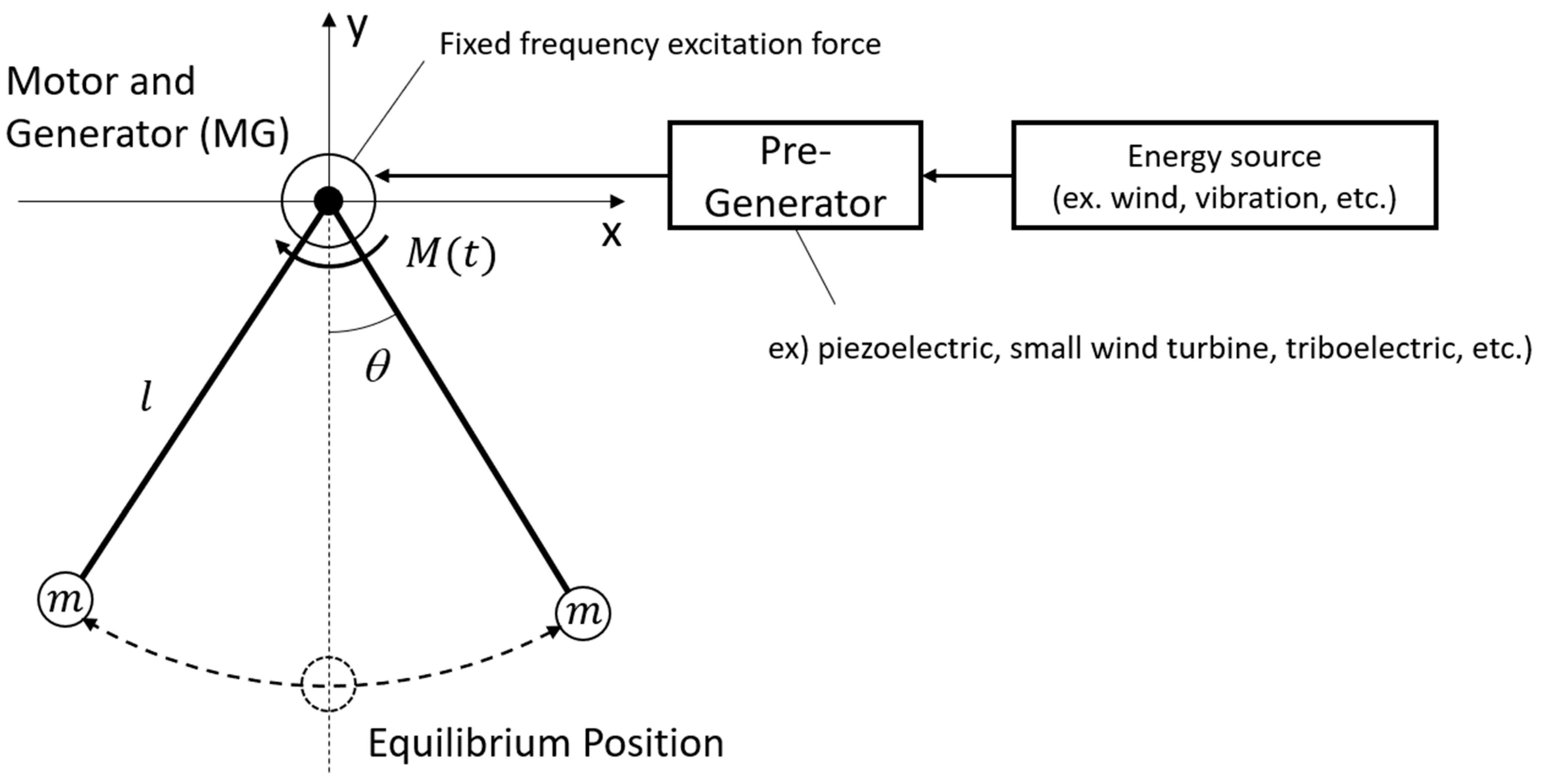
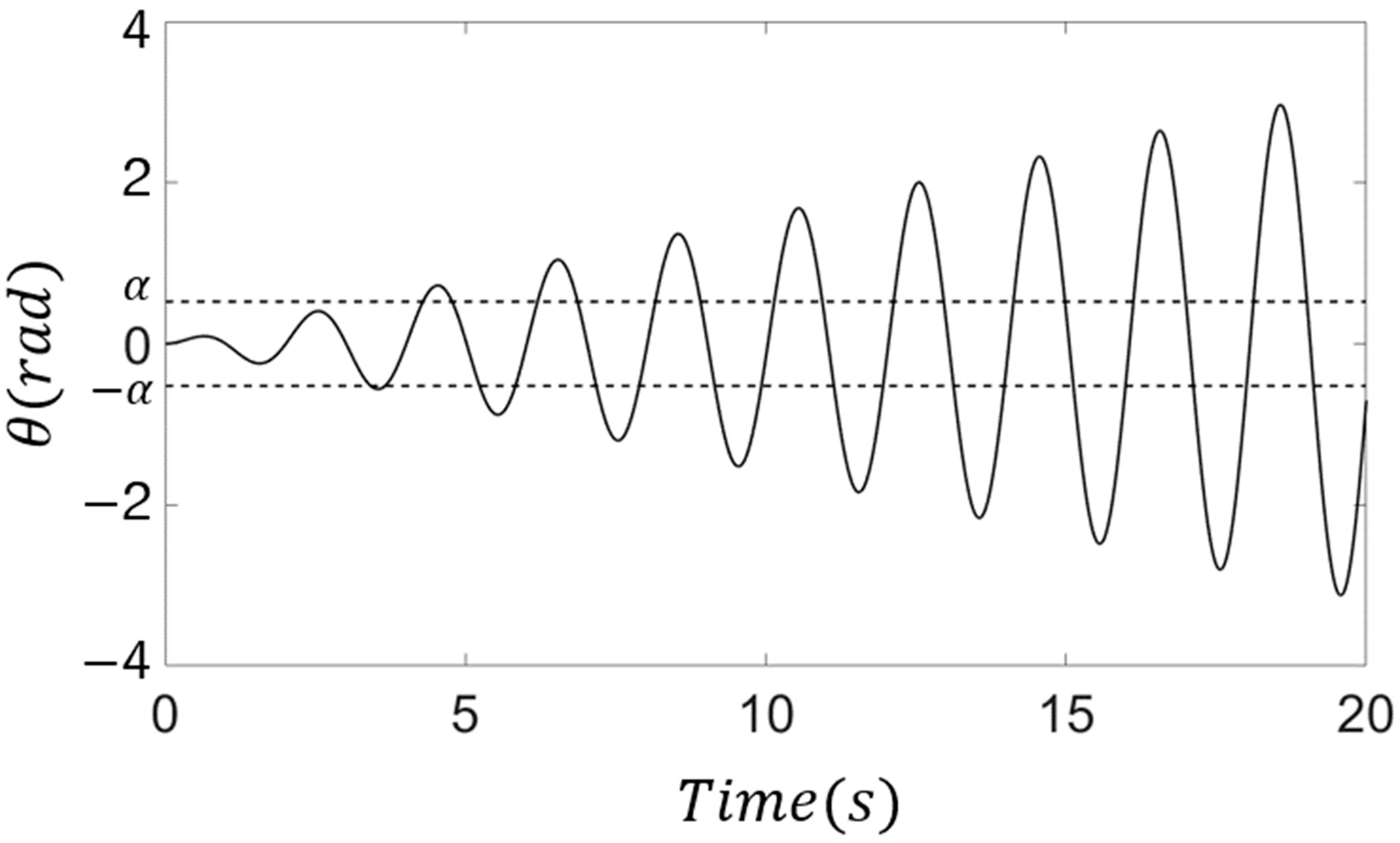
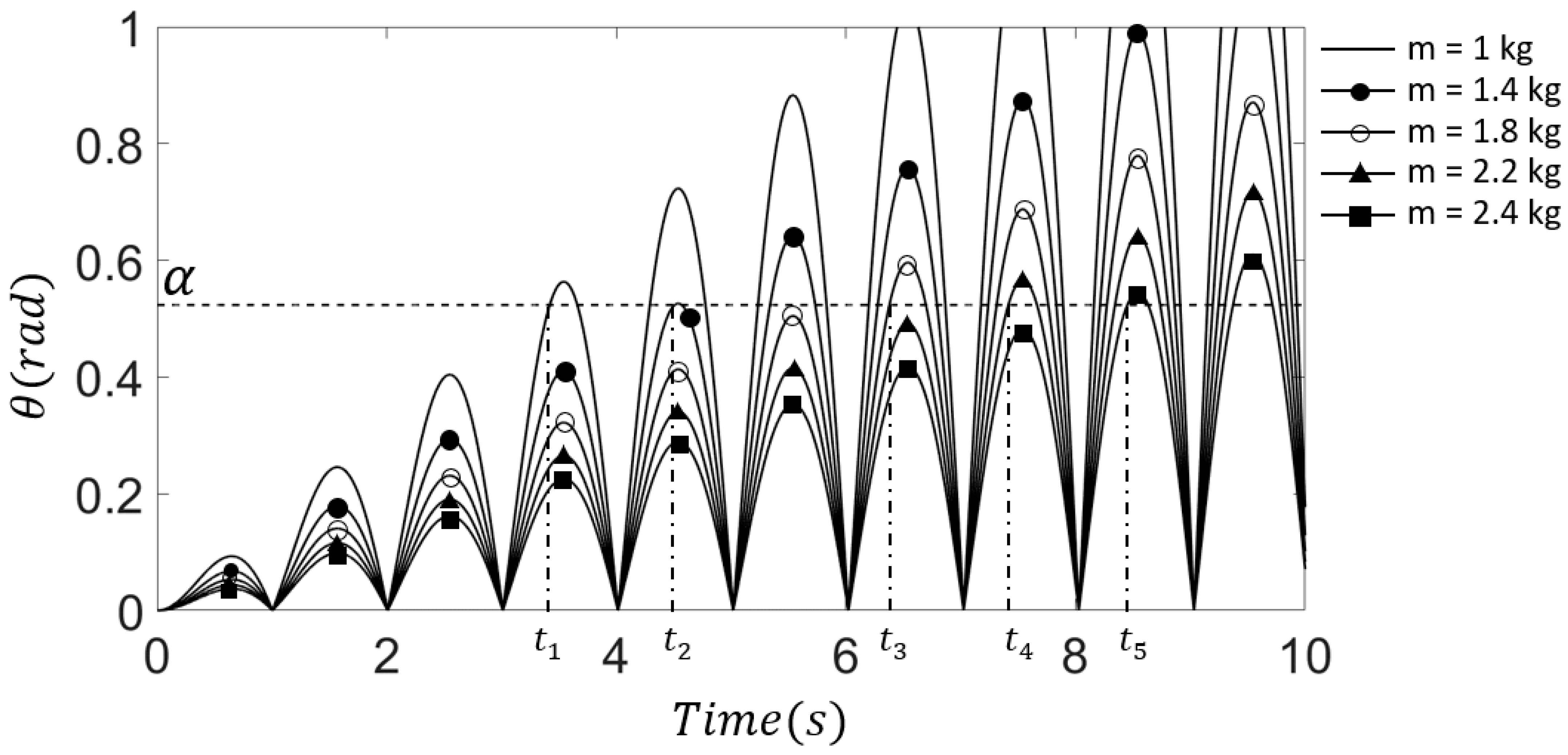

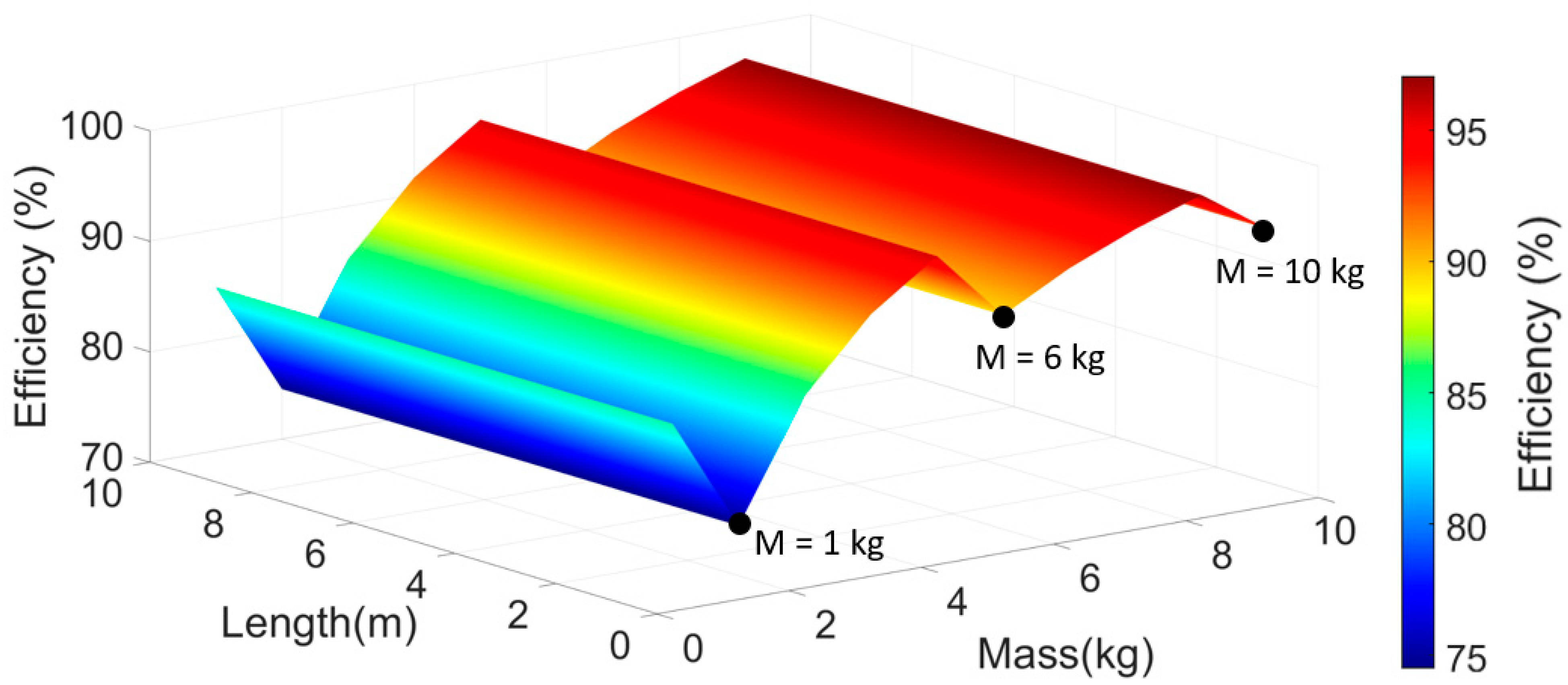

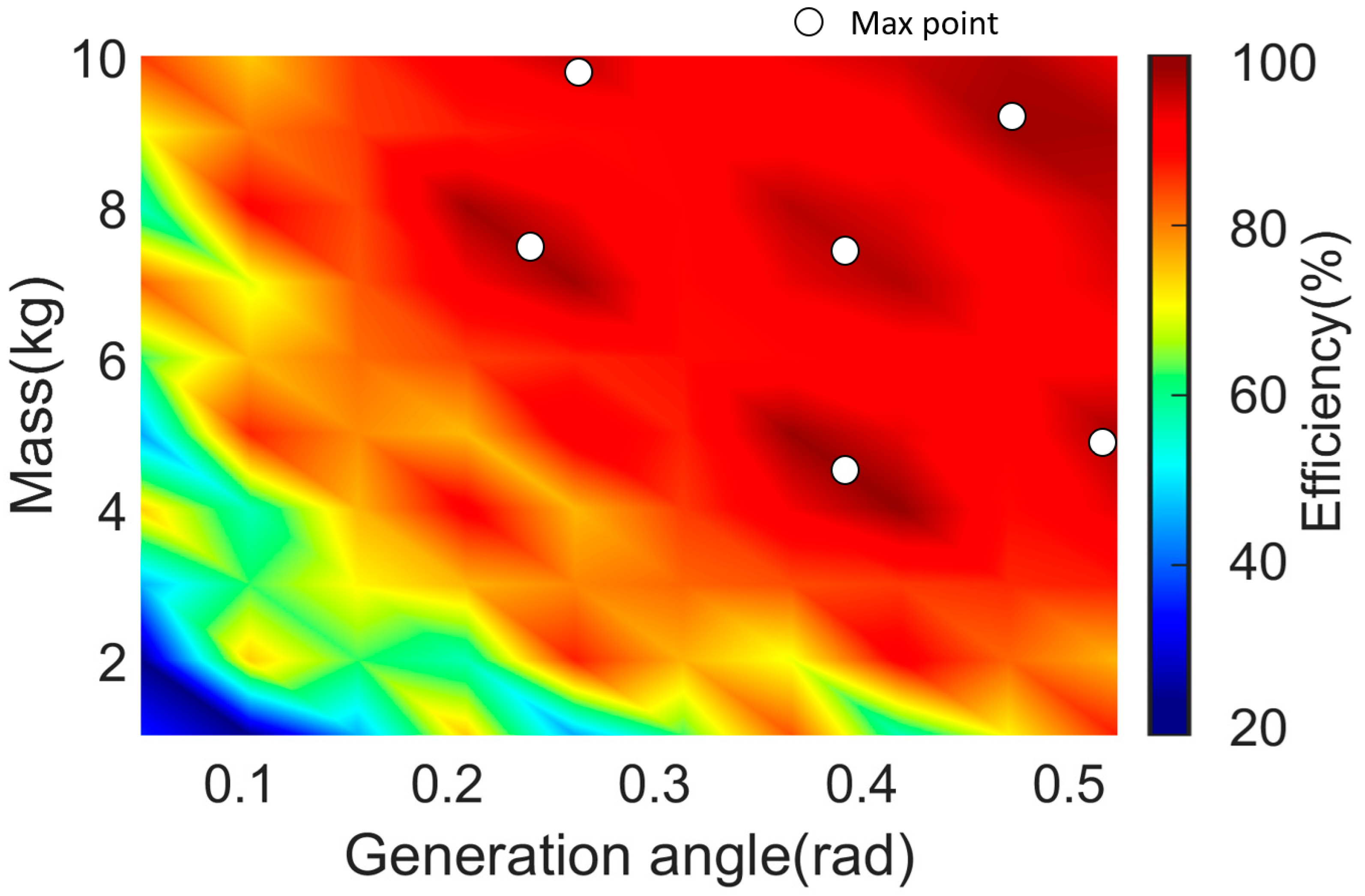
| Mass of Pendulum | |||
|---|---|---|---|
| 1 kg | 3.42 s | - | |
| 1.4 kg | 4.49 s | 1.05 s | |
| 1.8 kg | 6.37 s | 1.88 s | |
| 2.2 kg | 7.42 s | 1.05 s | |
| 2.4 kg | 8.46 s | 1.04 s |
Publisher’s Note: MDPI stays neutral with regard to jurisdictional claims in published maps and institutional affiliations. |
© 2022 by the authors. Licensee MDPI, Basel, Switzerland. This article is an open access article distributed under the terms and conditions of the Creative Commons Attribution (CC BY) license (https://creativecommons.org/licenses/by/4.0/).
Share and Cite
Kim, H.; Lee, S. A Study on the Efficiency in the Energy Harvesting Device Using Resonance of Pendulum. Appl. Sci. 2022, 12, 11862. https://doi.org/10.3390/app122211862
Kim H, Lee S. A Study on the Efficiency in the Energy Harvesting Device Using Resonance of Pendulum. Applied Sciences. 2022; 12(22):11862. https://doi.org/10.3390/app122211862
Chicago/Turabian StyleKim, Hyunsu, and Sangwoo Lee. 2022. "A Study on the Efficiency in the Energy Harvesting Device Using Resonance of Pendulum" Applied Sciences 12, no. 22: 11862. https://doi.org/10.3390/app122211862
APA StyleKim, H., & Lee, S. (2022). A Study on the Efficiency in the Energy Harvesting Device Using Resonance of Pendulum. Applied Sciences, 12(22), 11862. https://doi.org/10.3390/app122211862






